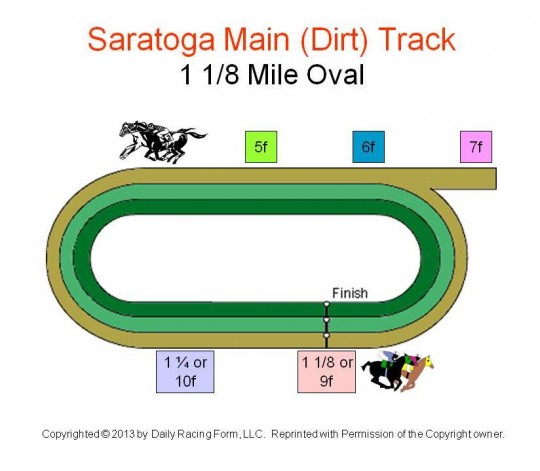Starting Gate Location Can Make The Same Post Position Good … Or Bad.
Post position refers to the position of each horse in the starting gate, starting from the inside rail and working out. This is usually, though not always the same number as the wagering number for each horse. The times when it differs is when you have a “coupled” entry in a race. A coupled entry is when two or more horses are running for the same common ownership.
Looking at the picture to the left, and working from the inside out, you can see that the #2 horse is in post one, #3 in post two, #4 in post three, etc. Following #7 is the #1A horse in post seven. #8 must have been scratched, so #9 follows #1A in post eight. Since there is no #1 horse, we know that he must have been scratched too.
Post positions in and of themselves are not important. Post positions relative to where the starting gate is located on the track, the running style (e.g. early speed vs. closer) for each horse, and the size of the field are quite important.
For example, an inside post position when the gate is located only a few hops from the first turn is helpful to almost any horse, and greatly advantageous to a horse with fast-breaking early speed. On the other hand, an outside post position in the same situation is a serious disadvantage. Even if the horse has enough speed to run up to the front before the first turn, he must use some energy to get there, which could compromise his chances later.
If he cannot get to the front by the first turn, then he risks losing precious ground to the field going wide around the turn. And if the horse is not in the capable hands of a quality jockey, he might end up going wide around successive turns as well. He could end up running substantially more distance than the other horses located to his inside.
In other circumstances, the outside post can be an advantage. If the starting gate is located at the beginning of a long, straight run to the first turn, a horse lacking quality tactical speed might get caught inside by other horses passing him early. As where the horse on the outside can let the frontrunners vie for the lead, while he settles in behind them, usually in a favorable position flanking the horses caught inside.
To show a comparison, look at the track configuration for the main track at Saratoga:

Notice that the starting gate for the 1 1/8 (9f) distance is located immediately before the first turn. To give you an idea of how much of a disadvantage the outside post can be for this distance, in the first 14 days of the 2013 meet, horses in post positions 6 to 9 were a combined 2 for 34.
Contrast that to races held at 7 furlongs, where the starting gate is located in a chute to the far right. Horses have the entire length of the backstretch to get into position before having to make their first (and only) turn for a 7f race. This makes the outside post position a non-issue, and in fact sometimes an advantage for horses that like to run “uncovered.” You will hear trainers use this term sometimes to refer to horses that do their best running from the outside of the pack.
We’ll complete this discussion with a review of the 2012 Hopeful Stakes and then a video replay. The two favorites were Fortify (#4) and Shanghai Bobby (#2B). They broke from post position #4 and #8 respectively.
Now maybe if they switched post positions the result is the same, but I noticed that Fortify did have to work a little harder in this race. First, he bumped with another horse out of the gate, then he moved up quickly and pressed the pace from the inside, had to move out and go around two tiring horses entering the stretch, and was flanked by #1 down the lane.
Contrast that with Shanghai Bobby, who broke from the farthest outside post position, waited for others to rush up to the lead, ranged up to them before the turn, and cruised around them before pulling away in the stretch. He might have been the better horse anyway, but his trip from the outside post position likely contributed to the relative ease in which he won the race.


4 comments on “Starting Gate Location Can Make The Same Post Position Good … Or Bad.”